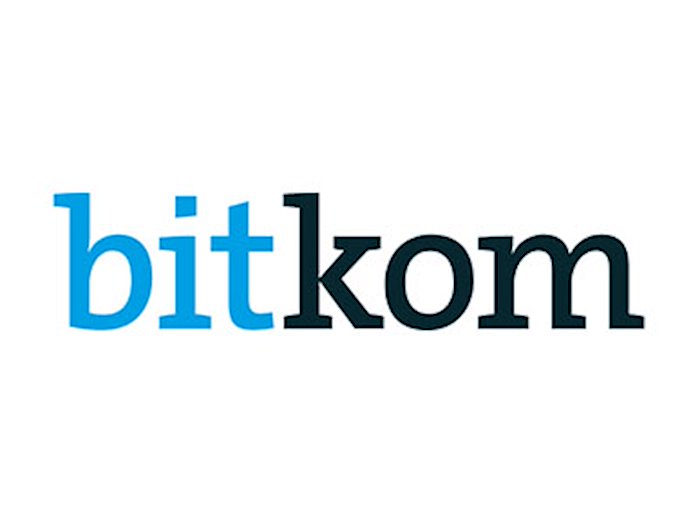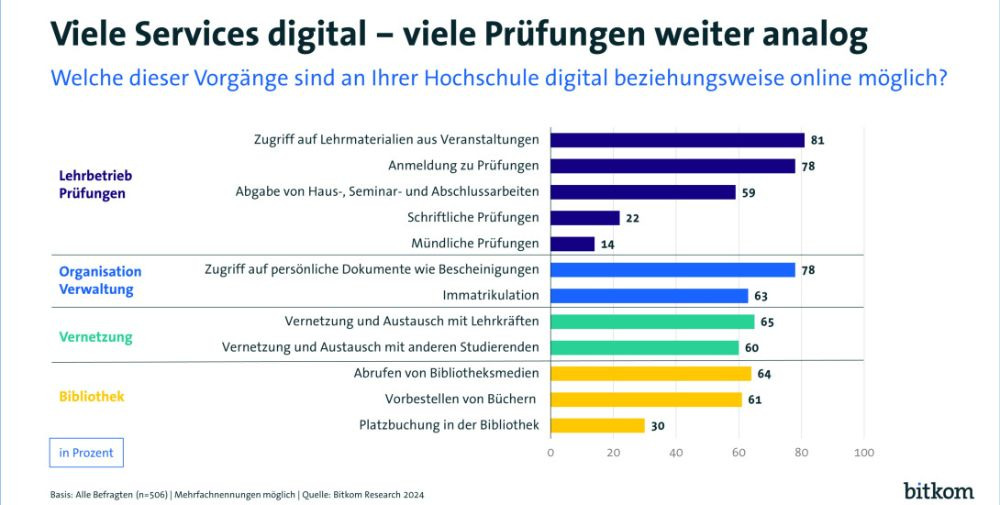
“Artificial intelligence has become an integral part of university life. Many students use generative AI such as ChatGPT, but only very few universities know how to use it, for example in exams, coursework or scientific research,” says Bitkom President Dr. Ralf Wintergerst. So far, students have mainly used ChatGPT as a research tool: 68 percent of users use it for this purpose, 40 percent for creating summaries, 37 percent each for preparing presentations and correcting texts, and 35 percent for translating texts. But ChatGPT also plays a role in the examination context: a third (33%) have already used it for exam preparation, 26% for writing assignments, 9% for writing theses and 4% even during an ongoing exam.
Most students use AI – but only around a third have rules
Overall, however, students are divided when it comes to the use of AI for exams: 44% think that the use of ChatGPT for assignments and theses should be banned. 54 percent say that ChatGPT can give students an unfair advantage. At the same time, three quarters (74 percent) of students believe that they should learn how to use ChatGPT correctly at university. 44 percent think that the use of ChatGPT should be standard at all universities. On the other hand, 60 percent also believe that the use of ChatGPT leads to students thinking and learning less independently. Wintergerst: “Universities are special places because AI is being researched and worked with here at the same time. Banning students from using AI would therefore not only be unenforceable, but would also send the wrong signal for Germany as an AI location.”
Although the majority of students are already using AI, only a minority are being given rules to follow: A total of 37 percent of students know that their university has rules on the use of generative AI such as ChatGPT: 17 percent know of central rules for the university as a whole, while for a fifth (20 percent) rules are set by teaching staff in isolated cases. A third (33 percent) state that they have no rules and a further 30 percent do not know whether there are rules at their university or did not specify. Wintergerst: “A rule that nobody knows is meaningless. However, in order to keep things fair and binding for everyone in the examination context, it is important to create and implement transparent and clear rules. In order for the potential of the technology to be exploited, students and lecturers need certainty about what is prohibited, what is permitted and what is even desirable when using AI in science and teaching.”
7 out of 10 want more digitalization and use of digital technologies
In terms of digitalization in general, German universities have made a leap forward in recent years from the students’ perspective – but there is still some catching up to do internationally: 73 percent of students say that the coronavirus pandemic has led to a digitalization push at their university. Another 73% believe that German universities are lagging far behind in international comparison. 64% are of the opinion that German universities have missed out on digitalization. In contrast, 18 percent of students see German universities as pioneers of digitalization. Wintergerst: “Particularly in the international competition for the brightest minds and best ideas, it is important to bring universities up to speed digitally. Digital universities are a first-class location factor.”
All in all, students give the digitalization of their own university an average grade of 2.7. Germany’s universities therefore perform much better than Germany’s schools. But that doesn’t seem to be enough: 7 out of 10 students (68%) would like to see more digitalization and use of digital technologies at their university and 87% demand that universities invest more in digitalization. “Students expect universities to use digital technologies as naturally as they do themselves,” says Wintergerst. “To achieve this, universities need financial security. That’s why the federal Digital University program announced in the coalition agreement must come. Anyone who cuts back on the digitalization of education, of all things, is cutting back in the wrong place.”
In-person plus online: Hybrid courses are the favorite
From the library, from abroad or from home after all: the majority of students currently have the option of attending courses online if required: More than half (56 percent) of students are able to follow university activities online some of the time, and for 13 percent this is always possible. Hybrid courses, in which both face-to-face and online participation are possible, are favored by students. If they had to choose one type of course for the rest of their studies, 45% of students would choose the hybrid option. A third (36%), on the other hand, would opt for purely face-to-face courses, 13% for purely online courses and 6% for recorded courses that are available online. “If it’s up to the students, it’s not about abolishing the traditional on-site university, just about supplementing it with online offerings, flexibility and freedom of choice,” says Wintergerst.
Many services online – many exams still analog
Despite online offerings for lectures, seminars and the like, exams at universities are still largely analog: only 22 percent can take written exams online, oral exams 14 percent. However, many services at universities can be accessed digitally: 81% of students have online access to teaching materials from courses, 78% have access to personal documents such as certificates. Another 78 percent can register for exams online and 63 percent can enrol online. Wintergerst: “Digital solutions can take the pressure off administration in particular and help to make administrative processes efficient and convenient for both sides, especially at large universities with a large number of students. When it comes to digital transformation, German universities can be role models for schools and authorities.”
The students also see a need to catch up in some areas of the existing digital infrastructure. For 27 percent, the most urgent problem at their university is poorly functioning web portals, for example for exam registration. 26 percent of students complain about poor or no WLAN. In each case, 25 percent complain about poor technical equipment and outdated teaching content and materials. 24 percent see insufficient use of digital devices and educational media as one of the most pressing problems. In comparison: 26 percent complain about dilapidated university buildings. “Universities don’t have to reinvent the digital wheel every time. There are already digital best practices at many universities. Exchange must be promoted so that universities can learn from pioneers. And it would be helpful to appoint CDOs at universities, just like in companies, i.e. digital officers at management level,” says Wintergerst.
Teaching staff are open-minded – but sometimes need additional know-how
In the courses themselves, digital devices are largely standard: 83 percent of students state that projectors are used in courses at least once in a while, 76 percent say this about laptops. Almost half (47%) use a smartboard or digital whiteboard, while 35% use stationary desktop PCs. Only a third (33%) of teaching staff use tablets in courses, while 21% use smartphones. Teaching staff are largely open to digital technologies: 65% of students say that their teaching staff have a rather positive attitude towards digitalization at their university, 14% even very positive. Only 11% see digitalization in a negative light. At the same time, however, just over a third (36%) of students say that the digitalization of their university is failing due to a lack of skills among teaching staff. Wintergerst: “The technology affinity of teaching staff is a good basis for meeting students’ desire for increased digitalization. Those who still have problems translating this openness into concrete applications should be given more support here, for example through more training and IT support.”
For the students themselves, digital devices are an integral part of their studies: Only 1 percent state that they never use digital devices for courses, as well as their preparation and follow-up work. Digital devices are mainly used to create presentations (79 percent), write texts (75 percent) and watch or listen to learning content (74 percent). 71% use digital devices for digital media, for example to read and edit digital scripts, and 69% use them to access learning platforms. At the same time, more than half of students would like to have more opportunities for further training: 53% would like more opportunities to develop their digital skills, such as scrum or programming courses. 38% say they are not prepared for the digital working world at their university. Wintergerst: “Hardly any job today is possible without digital skills. Digitality should therefore be integrated into the curricula of all degree courses as a cross-sectional competence. By providing sufficient licenses and technical equipment, universities must ensure that students can learn with digital devices and applications regardless of their budget.” Up to now, it has been standard practice for students to bear the costs of their own digital equipment: only 6 percent of students state that they are provided with a portable digital device such as a laptop or tablet by their university.
– – – – – –
Further links
👉 www.bitkom.org
👉 Presentation – Digital Universities 2024
Graphic: Bitkom




